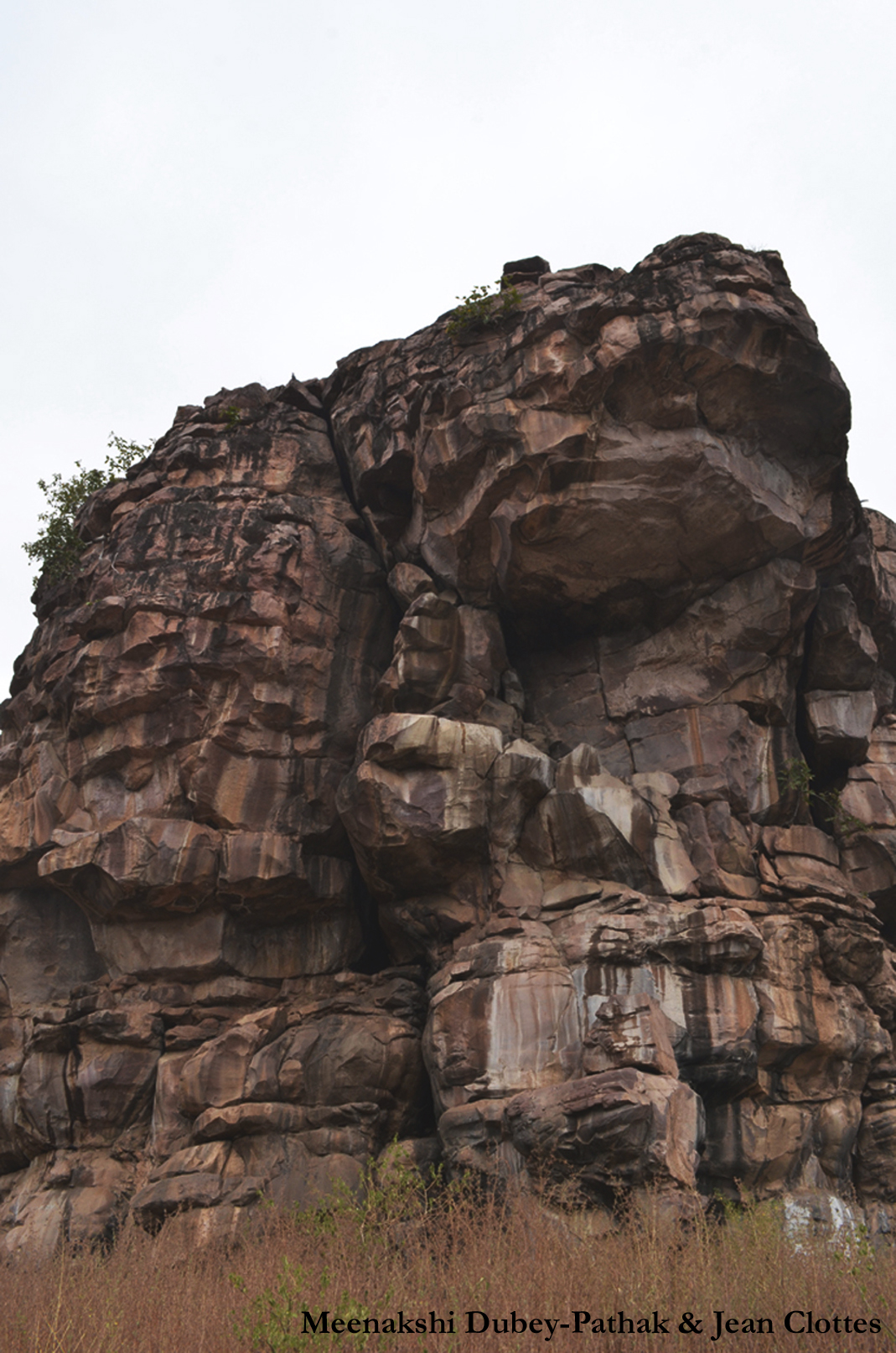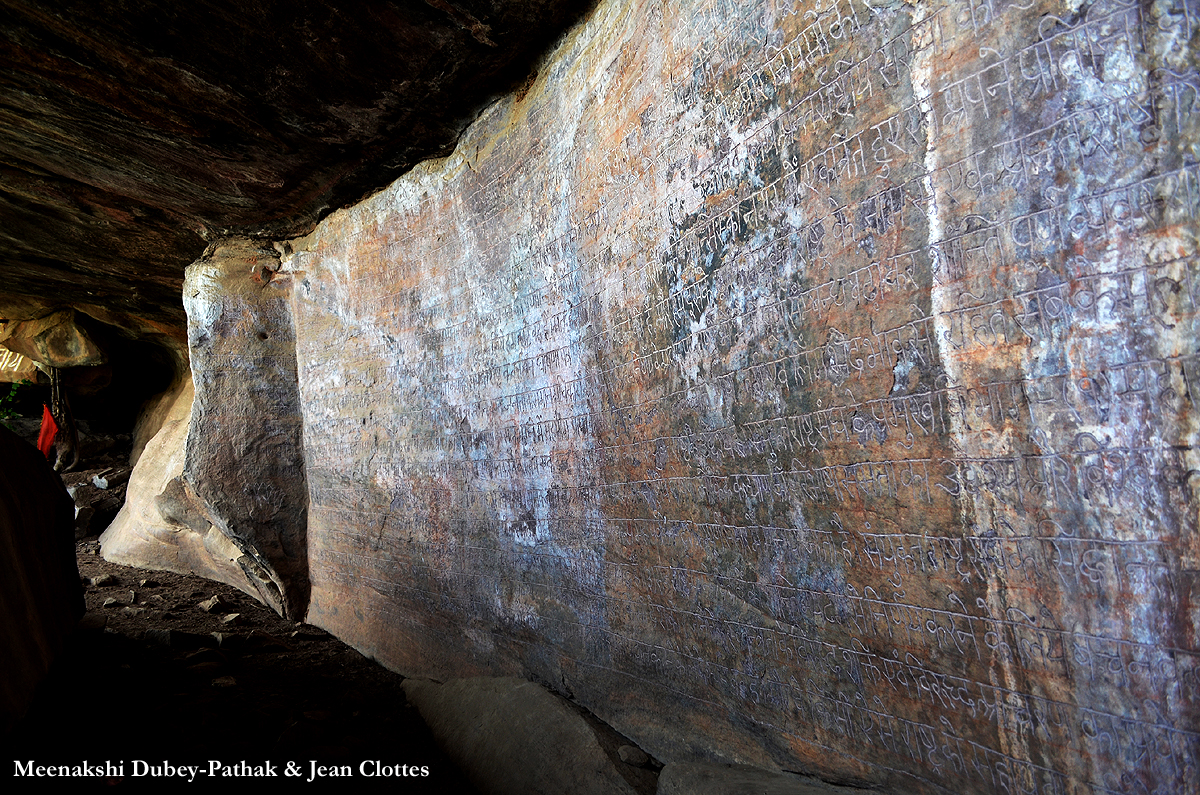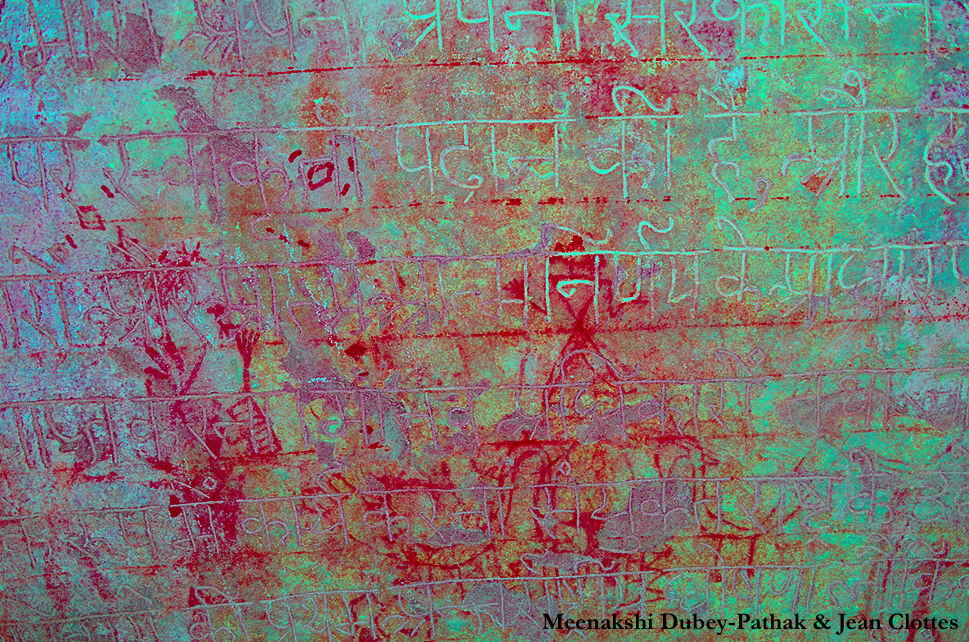


Meenakshi Dubey-Pathak continues her search for rock art in India.
Kharwai is a small village in the Raisen district of Madhya Pradesh. The area is partially covered with sandstone deposits that form numerous small shelters. Many of them were used at various times. We visited all of them and observed numerous rock paintings. Approaching Kharwai, a tower of rock stands some 25m high next to a river, locally known as Chidiyakho (Cave of Birds). Catching sight of it from a nearby road, we immediately thought that such a spectacular feature in the landscape would also have caught the attention of the ancients and been used as a place for rock art; it had.

With binoculars we spotted a few faded red paintings in a narrow recess about 7 or 8 meters up, in a place only reachable with artificial means. Once DStretched, we saw three stags and a probable hunter to the left, with a second human superimposed upon the stag in the middle at the bottom. Another image was that of a man with an arm upraised and curved holding something (possibly an axe) in his other hand, while to its right the blurred shapes were undecipherable. Finally, we observed a very strange complex sign.
Ritually Vandalized #RockArt Sites in #India #archaeology #Hindu #Shiva #DStretchhttps://t.co/kfSwYIrp1s pic.twitter.com/o14DHbFMLd
— Bradshaw Foundation (@BradshawFND) August 22, 2016
We went around the rock to a place with a natural shelter, fully expecting to find far more rock art in it. From what local people told us, this was indeed the case before a hermit selected it for his own use and entirely white washed the walls. Now the shelter holds the hermit's pallet, a fireplace, a small flowerbed, and many deposits like pots and flowers inside and next to a small natural recess. Various drawings were made on top of the white surface, including a serpent and dots.

About 600 hundred meters up a neighboring hill, we were led by our local guide to another shelter, at one extremity of which we immediately spotted a contemporary Hindu shrine devoted to the worship of Lord Shiva, with the sacred lingam symbolic of the god, on which were painted various signs (tridents, and the local name of the God Shiva) with the usual metal trident next to it.

The shelter was about 20 meters long, with an overhang of about 4 or 5 meters. We spotted faint traces of rock art here and there, but the wall was entirely covered over to a height of about 2 meters with long lines of Hindi script. The script had destroyed most of the ancient rock art as it had been deeply carved into the stone wall in big letters. At the left extremity of the text, a globe and a rather elegant elephant bearing a swastika had also been carefully engraved.
Before the elephant, on the left side of the wall in front of the Shiva Lingam, an official notice entitled 'Constitution of India' had been engraved between two carved lotuses, with the Emblem of India on the right side and the Ashoka Chakra (equivalent to the Buddhist Dharmachakra, represented with 24 spokes) on the left. The date of 26 November 1949, when the Constitution of India was established, was also engraved, with the text of the Preamble.
We then asked our villager informants what they knew about the shelter; they told us that about 35 years ago, in the 1970's, a dozen or so people had come to the village and remained there for two weeks, each day going to the shelter to carry on their carving. They were at great pains to write in straight lines and to deeply engrave their texts. The villagers, who could not read, told us that they were persuaded that the script was religious; for them it was a kind of spiritual renewal of the painted site and thus acceptable.
Meenakshi Dubey-Pathak
Ref: In 2013, 'Two Ritually Vandalized Rock Art Sites' , International newsletter INORA, no.67 (IBAN-FR7613135000800810229531780), France (pg no.19-27).
All images: Meenakshi Dubey-Pathak & Jean Clottes
Visit the India Rock Art Archive:
http://www.bradshawfoundation.com/india/index.php
by Bradshaw Foundation
Monday 30 May 2022
by Bradshaw Foundation
Wednesday 19 January 2022
by Bradshaw Foundation
Thursday 06 January 2022
by Bradshaw Foundation
Monday 06 December 2021
by Bradshaw Foundation
Monday 29 November 2021
by Bradshaw Foundation
Monday 25 October 2021
by Bradshaw Foundation
Monday 12 July 2021
by Bradshaw Foundation
Monday 24 May 2021
by Bradshaw Foundation
Tuesday 20 April 2021
by Bradshaw Foundation
Thursday 01 April 2021
by Bradshaw Foundation
Tuesday 23 February 2021
by Bradshaw Foundation
Thursday 14 January 2021
by Bradshaw Foundation
Friday 18 December 2020
by Bradshaw Foundation
Sunday 06 December 2020
by Bradshaw Foundation
Thursday 26 November 2020
by Bradshaw Foundation
Wednesday 07 October 2020
by Bradshaw Foundation
Monday 30 May 2022
by Bradshaw Foundation
Wednesday 19 January 2022
by Bradshaw Foundation
Thursday 06 January 2022
by Bradshaw Foundation
Monday 06 December 2021
by Bradshaw Foundation
Monday 29 November 2021
by Bradshaw Foundation
Monday 25 October 2021
by Bradshaw Foundation
Monday 12 July 2021
by Bradshaw Foundation
Monday 24 May 2021
by Bradshaw Foundation
Tuesday 20 April 2021
by Bradshaw Foundation
Thursday 01 April 2021
by Bradshaw Foundation
Tuesday 23 February 2021
by Bradshaw Foundation
Thursday 14 January 2021
by Bradshaw Foundation
Friday 18 December 2020
by Bradshaw Foundation
Sunday 06 December 2020
by Bradshaw Foundation
Thursday 26 November 2020
by Bradshaw Foundation
Wednesday 07 October 2020
Friend of the Foundation











